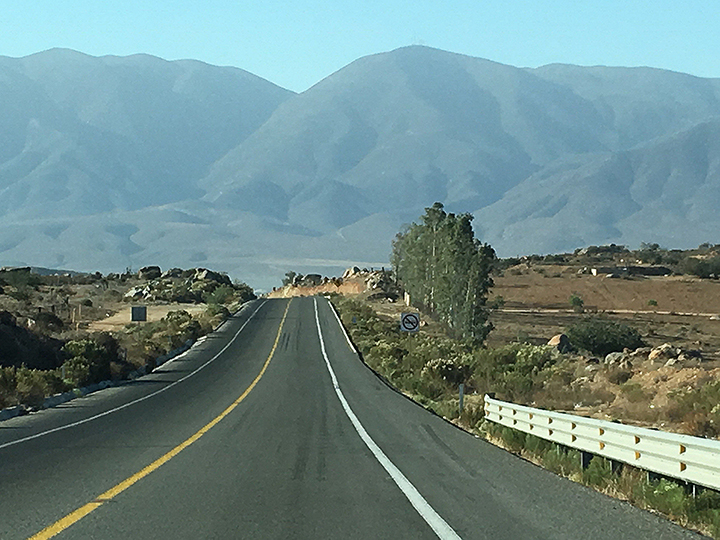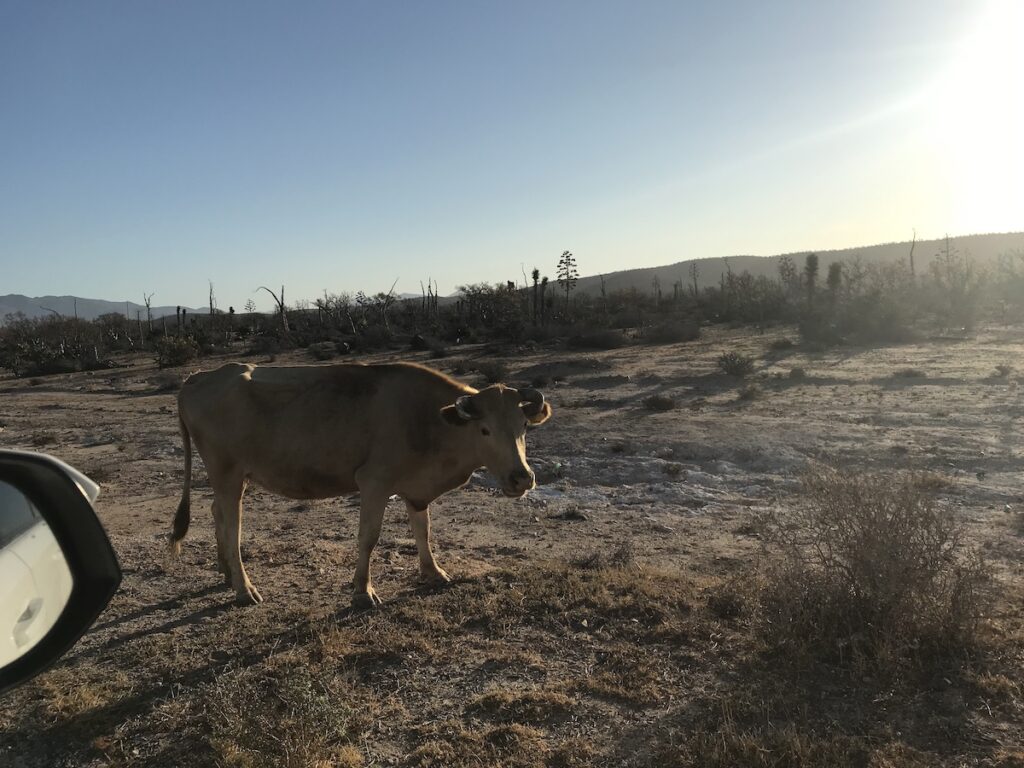Tips for making your Baja Road Trip Fun, Safe and Worry-Free
Part I – Preparing for Your Trip
Driving the Baja peninsula is a fun adventure filled with stunning scenery, quirky small towns, remote beaches, and opportunities for great photos. The drive from the US/Mexico border in California or Arizona to La Paz in Baja California Sur is a 900+ mile trip that can take two or more days, depending on your itinerary.
Why would anyone choose to drive to La Paz instead of flying? There are many reasons. Maybe you just purchased your home in La Paz and want to bring down some of your household goods and/or a vehicle to use here. Maybe you have pets and want to bring them with you. Or maybe you just want to take your time, see the sights, and stop to camp along the way for a few nights here and there.
Regardless of your reasons, we’ve gathered some tips to help you make your drive fun, hassle-free and safe. In Part I of our series, we discuss:
- Is it safe? The number one question on new visitors’ minds.
- Immigration requirements: what paperwork do I need to cross the border?
- What can I bring with me? Will I have to pay to bring my household goods?
- Can I bring my pets? What documentation will I need?
- Vehicle requirements: do I need a temporary import permit?
- More tips on how to prepare
In future posts, we’ll provide tips on the different border crossings, and how to plan your stops along the way.

Is it Safe to Drive in Baja?
The first question visitors contemplating a road trip to La Paz usually ask is whether it’s safe to drive. The answer is yes, as long as you plan ahead and prepare yourself with some local knowledge. A paved (except for a few construction zones) highway runs the entire length of the peninsula, and the biggest danger comes from cars passing on hairpin mountain turns, and free range cows, horses, goats and other animals that often wander into the road. As long as you take your time, drive carefully, and don’t drive at night (it’s hard to see those cows at night!) you will find the trip to be safe and enjoyable. If you do have car trouble, you will most likely discover some of the magic of Baja: fellow travelers have shared hundreds of stories of friendly strangers who often appear out of nowhere to help if you get stranded. It’s part of what makes Baja such a wonderful place to live and travel through! Also, you will occasionally see white trucks with green coloring. They are called the Green Angels, and they operate like AAA but free of charge. The toll-free number 078 (from a Mexican phone) will connect you with them and send the closest truck your way.

Immigration Requirements
To enter Mexico, you must present a current passport that will be valid for the length of your stay in Mexico. In some cases, Mexican immigration may also require it to have an additional 6 months of validity. If you do not have a temporary or permanent resident visa yet, you must also fill out the FMM Tourist Permit. These are available online here https://www.inm.gob.mx/fmme/publico/en/solicitud.html or at the immigration office at the border. Be sure to make copies of your legal paperwork in case the originals are ever lost.
What Can I Bring with Me?
If you have recently purchased a home and want to bring some of your household goods with you to Mexico, you are allowed to bring them, with some limitations. In general, used household items can be brought down free of charge as long as customs approves the items. Any new merchandise (especially items in the original packaging) are subject to import fees of 16% on the assessed value.
Some items are regulated or prohibited. Fresh fruit and vegetables, meat, and dog food are all items that could be denied at entry. If you have a gas can, make sure it is empty when you cross. If you are bringing in any alcohol or tobacco, you have limits on how much you can bring into Mexico. As of this post, the limits on alcohol are 3 liters of liquor or beer and 6 liters of wine per adult. The limits on tobacco are 2 cartons of cigarettes or 50 cigars.
Of course, you should always check with the appropriate authority to make sure you are adhering to the current requirements. As for weapons, the best recommendation is to NOT bring any firearms or other weapons into Mexico. They are illegal to possess unless you have met a long list of requirements, and even then they are heavily restricted. Even carrying a pocket knife can get you in trouble, so it’s always best to stay on the safe side. If you are bringing prescription medications with you, have a copy of the prescription handy in case they ask for it. Check here for more information: https://mx.usembassy.gov/u-s-citizen-services/local-resources-of-u-s-citizens/bringing-items-into-mexico-u-s/
Can I Bring My Pets?
It’s perfectly legal to bring your domestic pets, such as cats or dogs, into Mexico, but there are requirements you need to follow. At a minimum, you should have a current health certificate from your veterinarian that is no more than 15 days old. The health certificate should show proof of rabies and distemper vaccines as well as anti-parasite treatment within 6 months. While many people cross the border with pets and are never asked for documentation, it is best to be prepared and have your paperwork in order in case you are asked.
Check here for the full requirements: https://consulmex.sre.gob.mx/montreal/index.php/en/foreigners/services-foreigners/312-taking-pets-to-mexico.

Vehicle Requirements
There is a lot of conflicting information online about the rules around importing your car to Mexico. While it’s true that you need to get a vehicle import permit to drive on the mainland in Mexico, you do NOT need to import your US or Canadian plated vehicle to drive in Baja. The entire Baja peninsula is designated as part of the Mexico Free Zone by the Mexican government to make it easier for travelers to enter Mexico and improve tourism along the U.S. border. Vehicles driving in these zones do not need a Temporary Vehicle Importation Permit (TIP). You can legally drive your US or Canadian plated vehicle throughout the entire Baja peninsula without a TIP, as long as your US or Canadian registration and driver’s license are current. You will, however, need Mexican insurance to drive throughout Baja. It’s very important to purchase this before you cross the border. It’s easy and low-cost to purchase, you can find full details and insurance options here: www.bajabound.com. Before you begin your Baja journey, you should get your vehicle inspected by a mechanic just to make sure all the main systems are operating correctly.

Final Preparations
As your departure date approaches, here are some things to double-check:
- Get some Mexican pesos. Many of the services here will only accept cash, so you will need to have some pesos. Your bank can usually exchange some dollars to pesos (at a good rate), and they can even give you smaller bills, something we highly recommend since many locals in Baja won’t have change.
- Upgrade your cell phone plan to add international roaming. Most carriers will let you upgrade your plan for just one month while you are traveling abroad. You can remove the upgrade when you return and go back to your standard plan. Doing this can save you tons on unanticipated roaming charges.
- Download Google Maps. If you don’t already have the Google Maps app, download it and then download the Baja Peninsula map, so that you can access it even when you don’t have a cell signal (which will happen several times during the trip). Now, look up the hotels and landmarks you are planning to visit (we’ll have more on this in Part II of our series on Driving Baja) and save them in the app so you can easily set them as destinations.
- Prepare a basic emergency kit. Just in case some unplanned event pops up, it’ll save you time and sanity to have some basic necessities. A tire pump and some slime, flares, a flashlight, fresh water, some rope, jumper cables and/or a jump starter, and a basic tool kit can come in handy. There are many online resources that offer suggestions on the best items to bring with you.
- Join a Facebook group. Ask to be added to a group like Talk Baja and Talk Baja Road Conditions, where travelers often post updates on the current status of weather forecasts and road conditions. Be aware that Facebook groups are often full of opinions, take each with a grain of salt and balance it out with your own common sense and good judgement.
So now you’re ready for your first Baja trip!
Click here for Part II in our Driving Baja series, where we discuss the different border crossings, and how to navigate the immigration and inspection process.
Click here for Part III in our Driving Baja series, where we discuss the trip down the Baja peninsula, including where to stop for gas, and where to stay the night.
